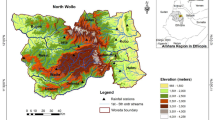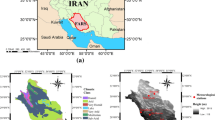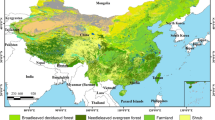Abstract
Due to the importance of drought, drought monitoring and variations impact analysis are necessary for preparing appropriate management approaches, but rainfall data are very limited and of low distribution over the world. Remote sensing as an important tool has been widely used for drought managing and monitoring. To do this, the Moderate Resolution Imaging Spectroradiometer (MODIS) data between the years 2000 and 2015 were used to derive Normalized Difference Vegetation Index (NDVI), Vegetation Condition Index (VCI), Temperature Condition Index (TCI), Vegetation Health Index (VHI), and Normalized Difference Water Index (NDWI). The 3-month Standardized Precipitation Index (SPI-3) using 31 meteorological stations located in Tehran province has been analyzed for the meteorological drought. In the next step, Pearson’s correlation coefficient between vegetation indices and SPI was used to select the best vegetation indices. Finally, the appropriate model between the 3-month SPI and vegetation indices were estimated. The results showed that the climate conditions in the study area had more consistency with the results from TCI and VHI. The results obtained to apply VHI and TCI show the severe drought in the years 2000, 2001, 2008, and 2015 in Tehran Province.









Similar content being viewed by others
Notes
A qanat is a system for transporting water from an aquifer or water well to the surface, through an underground aqueduct.
References
Akhtari R, Mahdian M, Morid S (2007) Assessment of spatial analysis of SPI and EDI drought indices in Tehran province. Iran-Water Resour Res 2(3):27–38
Amalo LF, Ma’rufah U, Permatasari PA Monitoring 2015 drought in West Java using Normalized Difference Water Index (NDWI). In: IOP Conference Series: Earth and Environmental Science, 2018. vol 1. IOP Publishing, p 012007
Andalibi F, Esmaeily A (2015) Vegetation water content estimation using vegetation indices of low resolution satellite data. Geosp Engin J 6:11–16
Askarimarnani SS, Kiem AS, Twomey CR (2021) Comparing the performance of drought indicators in Australia from 1900 to 2018. Int J Climat 41:E912–E934
Baaghideh M, Alijani B, Ziaian P (2011) Evaluating the possibility of using the NDVI index to analyze and monitor droughts in Esfahan Province. Arid Reg Geogr Stud 1(4):1–16
Bhuiyan C (2008) Desert vegetation during droughts: response and sensitivity. Int Soc Photogramme 37:907–912
Datt B (1999) Remote sensing of water content in Eucalyptus leaves. Aust J Bot 47:909–923
Davidson A, Wang S, Wilmshurst J (2006) Remote sensing of grassland–shrubland vegetation water content in the shortwave domain International. Int J Appl Earth Obs 8:225–236
Du TLT, Bui DD, Nguyen MD, Lee H (2018) Satellite-based, multi-indices for evaluation of agricultural droughts in a highly dynamic tropical catchment, central Vietnam. Water-Sui 10:659
Dutta D, Kundu A, Patel NR (2013) Predicting agricultural drought in eastern Rajasthan of India using NDVI and standardized precipitation index. Geocarto Int 28(3):192–209. https://doi.org/10.1080/10106049.2012.679975
Dutta D, Kundu A, Patel NR, Saha SK, Siddiqui AR (2015) Assessment of agricultural drought in Rajasthan (India) using remote sensing derived Vegetation Condition Index (VCI) and Standardized Precipitation Index (SPI). Egypt J Remote Sens 18(1):53–63. https://doi.org/10.1016/j.ejrs.2015.03.006
Guenang GM, Kamga FM (2014) Computation of the Standardized Precipitation Index (SPI) and its use to assess drought occurrences in cameroon over recent decades. J Appl Meteorol Climatol 53(10):2310–2324
Gao BC (1996) NDWI—A normalized difference water index for remote sensing of vegetation liquid water from space. Remote Sens Environ 58(3):257–266
Gulácsi A, Kovács F (2015) Drought monitoring with spectral indices calculated from MODIS satellite images in Hungary. J Environ Geogr 8:11–20
Gutman GG (1991) Vegetation indices from AVHRR: an update and future prospects. Remote Sens Environ 35:121–136
Hayes MJ, Svoboda MD, Wiihite DA, Vanyarkho OV (1999) Monitoring the 1996 drought using the standardized precipitation index. B Am Meteorol Soc 80:429–438
Heim RR Jr (2002) A Review of Twentieth-Century Drought Indices Used in the United States B. Am Meteorol Soc 83:1149–1166
Jackson RD, Idso SB, Reginato RJ, Pinter PJ Jr (1981) Canopy temperature as a crop water stress indicator. Water Resour Res 17(4):1133–1138
Ji L, Peters AJ (2003) Assessing vegetation response to drought in the northern Great Plains using vegetation and drought indices. Remote Sens Environ 87:85–98
Khanmohammadi F, Homaee M, Noroozi AA (2015) Soil moisture estimating with NDVI and land surface temperature and normalized moisture index using MODIS images. J Soil Water Conserv 4(2):37–45
Kloos S, Yuan Y, Castelli M, Menzel A (2021) Agricultural drought detection with MODIS based vegetation health indices in southeast Germany. Remote Sens 13:3907
Kogan FN (1990) Remote sensing of weather impacts on vegetation in non-homogeneous areas. Int J Remote Sens 11(8):1405–1419
Kogan FN (1995) Application of vegetation index and brightness temperature for drought detection. Adv Space Res 15(11):91–100
Kogan FN (1997) Global drought watch from space. B Am Meteorol Soc 78(4):621–636
Kogan FN (2002) World droughts in the new millennium from AVHRR-based vegetation health indices. Eos, Transac Am Geophys Union 83(48):557–563
Kundu A, Dwivedi S, Dutta D (2016) Monitoring the vegetation health over India during contrasting monsoon years using satellite remote sensing indices. Arab J Geosci 9(2):144. https://doi.org/10.1007/s12517-015-2185-9
Kundu A, Denis DM, Patel NR, Mall RK, Dutta D (2020a) Techniques for Disaster Risk Management and Mitigation, Chapter 13: Geoinformation Technology for Drought Assessment, John Wiley & Sons Inc. press 171–180
Kundu A, Patel NR, Denis DM, Dutta D (2020b) An estimation of hydrometeorological drought stress over the central part of India using geo-information technology. J Indian Soc Remote 48(1):1–9. https://doi.org/10.1007/s12524-019-01048-9
Kundu A, Dutta D, Patel NR, Denis DM, Chattoraj KK (2021) Evaluation of socio-economic drought risk over Bundelkhand Region of India using Analytic Hierarchy Process (AHP) and Geo-Spatial Techniques. J Indian Soc Remote. https://doi.org/10.1007/s12524-021-01306-9
Lashanizand M, Telvari AR (2004) An investigation on climatological droughts and it’s prediction of feasibility in six basins in west and north west of Iran. Geogr Res 19(1):73–86
Liu WT, Kogan FN (1996) Monitoring regional drought using the vegetation condition index. Int J Remote Sens 17(14):2761–2782
McKee TB, Doesken NJ, Kleist J (1993) The relationship of drought frequency and duration to time scales. In: Proceedings of the 8th Conference on Applied Climatology, 1993. vol 22. Boston, pp 179–183
Meng L, Dong T, Zhang W (2016) Drought monitoring using an Integrated Drought Condition Index (IDCI) derived from multi-sensor remote sensing data. Nat Hazards 80:1135–1152
Montandon L, Small E (2008) The impact of soil reflectance on the quantification of the green vegetation fraction from NDVI. Remote Sens Environ 112:1835–1845
Morid S, Moghaddasi M (2005) Monitoring the drought during 1998 to 2000 in Tehran province, using EDI, SPI, DI indices and geographical information system. J Settl Spat Plan 9:197–215
Orhan O, Ekercin S, Dadaser-Celik F (2014) Use of landsat land surface temperature and vegetation indices for monitoring drought in the Salt Lake Basin Area, Turkey. Sci World J 2014
Parida BR, Collado WB, Borah R, Hazarika MK, Samarakoon L (2008) Detecting drought-prone areas of rice agriculture using a MODIS-derived soil moisture index. Gisci Remote Sens 45(1):109–129. https://doi.org/10.2747/1548-1603.45.1.109
Patel NR, Parida BR, Venus V, Saha SK, Dadhwal VK (2012) Analysis of agricultural drought using vegetation temperature condition index (VTCI) from Terra/MODIS satellite data. Environ Monit Assess 184(12):7153–7163. https://doi.org/10.1007/s10661-011-2487-7
Sahoo RN, Dutta D, Khanna M, Kumar N, Bandyopadhyay SK (2015) Drought assessment in the Dhar and Mewat Districts of India using meteorological, hydrological and remote-sensing derived indices. Nat Hazards 77(2):733–751. https://doi.org/10.1007/s11069-015-1623-z
Shahabfar A, Ghulam A, Eitzinger J (2012) Drought monitoring in Iran using the perpendicular drought indices. Int J Appl Earth Obs 18:119–127
Shakya N, Yamaguchi Y (2007) Drought monitoring using vegetation and LST indices in Nepal and northeastern India. In: Proc. 28th Asian Conference on Remote Sensing
Singh RP, Roy S, Kogan F (2003) Vegetation and temperature condition indices from NOAA AVHRR data for drought monitoring over India. Int J Remote Sens 24(22):4393–4402
Thenkabail PS, Gamage M (2004) The use of remote sensing data for drought assessment and monitoring in Southwest Asia. Research Report 85. Colombo, Sri Lanka: International Water Management Institute
Tian M, Wang P, Khan J (2016) Drought forecasting with vegetation temperature condition index using ARIMA models in the Guanzhong Plain. Remote Sens-Basel 8(9):690
Wang J, Price K, Rich P (2001) Spatial patterns of NDVI in response to precipitation and temperature in the central Great Plains. Int J Remote Sens 22:3827–3844
Wang Q, Adiku S, Tenhunen J, Granier A (2005) On the relationship of NDVI with leaf area index in a deciduous forest site. Remote Sens Environ 94(2):244–255
Wilhite DA (2000) Drought as a natural hazard: concepts and definitions. In Wilhite, D. A. (ed.), Drought: A Global Assessment, London: Routledge, Vol. 1, pp.3–18
Zhong D, Lin P, Tian-He C, Xin Z, Wen-Ying W (2011) Drought monitoring in Southwest China with HJ data. In 2011 International Conference on Electronics, Communications and Control (ICECC), IEEE Publisher, 9–11 Sept. 2011 Ningbo, China (pp. 235–238)
Author information
Authors and Affiliations
Corresponding author
Ethics declarations
Conflict of interest
The authors declare that they have no competing interests.
Additional information
Responsible Editor: Biswajeet Pradhan
Rights and permissions
About this article
Cite this article
Hashemzadeh Ghalhari, M., Vafakhah, M. & Damavandi, A.A. Agricultural drought assessment using vegetation indices derived from MODIS time series in Tehran Province. Arab J Geosci 15, 412 (2022). https://doi.org/10.1007/s12517-022-09741-9
Received:
Accepted:
Published:
DOI: https://doi.org/10.1007/s12517-022-09741-9




